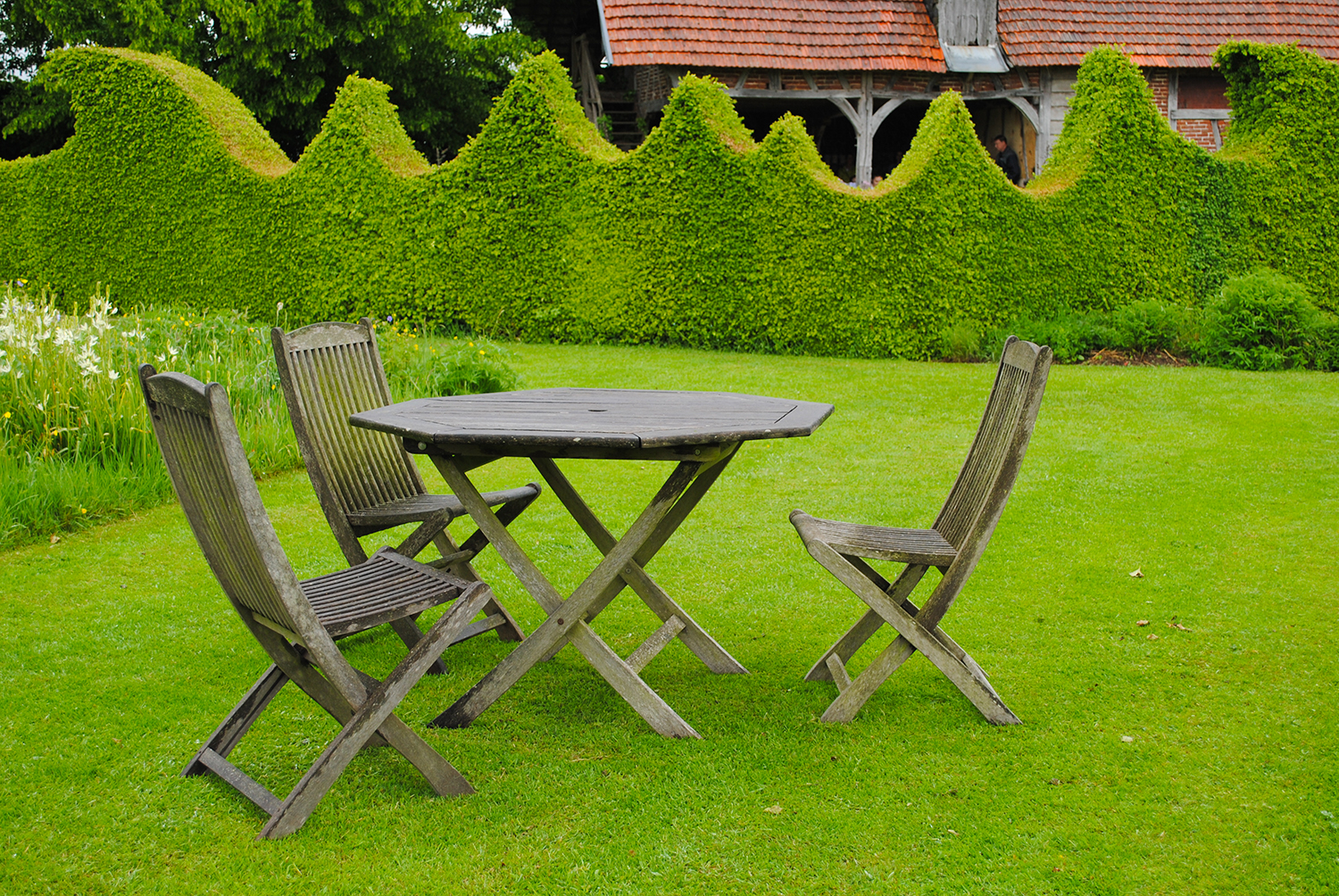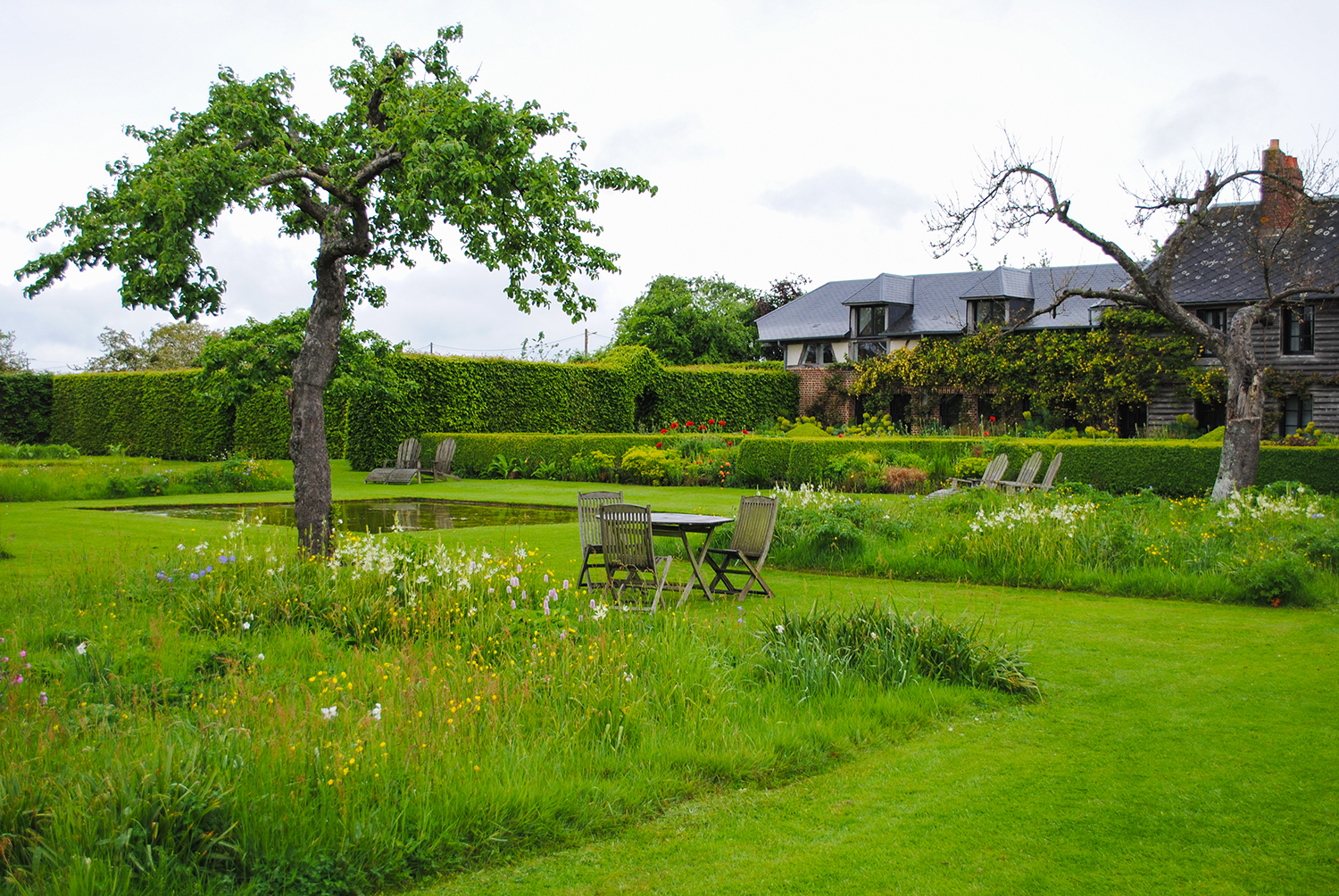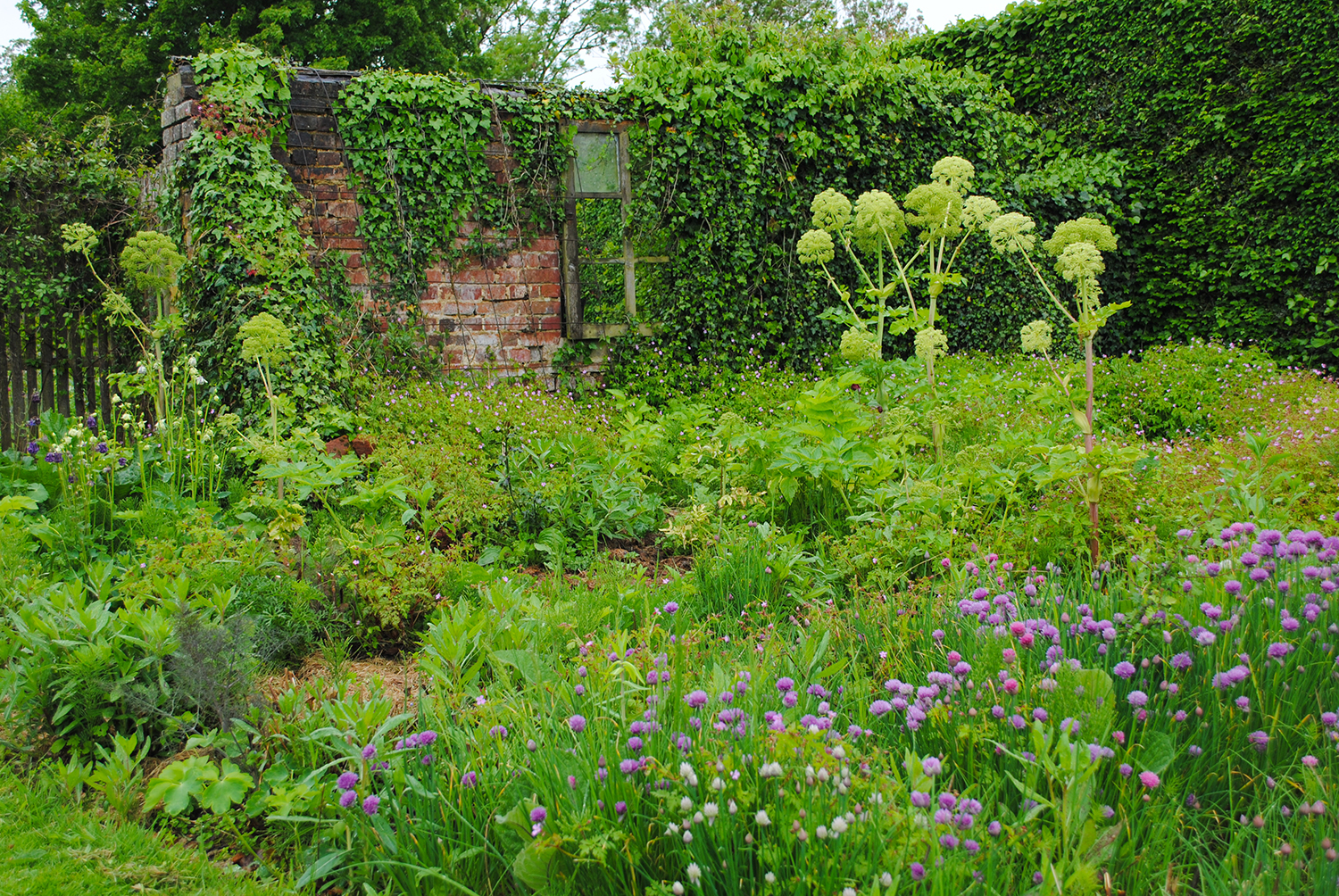In the fall of 2015, I was asked to help lead a study abroad trip with SFA students to France the following May, and when the discussion of great gardens to see arose, I immediately thought of Le Jardin Plume.
I can't recall the first time I saw images of the grasses and the manicured boxwood at Le Jardin Plume—probably from this article written by Stephen Lacey—but I do remember being mesmerized and enchanted by the photos.
I knew that Le Jardin Plume was a garden we had to visit. Why, you ask? Well, I wasn't being selfish in trying to mark off a bucket list garden, but I wanted to show students GREAT horticulture. The study abroad trip was a joint effort with agriculture/horticulture and interior design, architecture, and hospitality. I felt that the other majors outside of horticulture would enjoy design techniques employed with a different medium—plants. And, the people who I knew who had visited Le Jardin Plume raved about it being one of their favorite gardens in the world. Fortunately, it wasn't too far from Paris, our excursion center.
When I was in the garden, I did my best to soak up as much as I could and photograph everything. Now that I'm back stateside and some time has passed, I'm reflecting on what made the garden so attractive and appealing. Let's see, shall we.
Entering Le Jardin Plume for the first time! Giddy, giddy, giddy!
THE PERSONAL TOUCH
Le Jardin Plume, which translates as The Feather Garden, was started by Patrick and Sylvie Quibel approximately 20 years ago. Fortunately, they were there the day we visited, and as we braved a light mist, Patrick was able to share some perspective about the garden in French. Thanks to our group leader Aristea translating his introduction, we better understood the history and essence of the garden. I offer a typed, paraphrased version of his videoed dialogue for you below.
Patrick Quibel chatted with us about Le Jardin Plume's origins and design.
“There was no garden. It was just basically land with apple trees and lambs that would eat the grass. This is flat, windy land. Because of the wind, we have a lot of walls of hedges, and because we like fantasy, we cut them. This part beyond this garden is something constructed but at the same time gives total freedom to the plants.
We kept the Norman style garden in the middle because we didn’t want to touch that, but then we kept the alleys and the structure on the other side. Where you will be seeing the big squares with the high vegetation, we are trying to reintroduce diversity into the vegetation. Those plants are from around here. We are taking seeds from nature and reintroducing them to the garden. We introduce plants from outside from now and again, like the Camassia from North America, the blue and white. But, the blue are over for the season, and you are going to see that the whites are in bloom now. They are from North America.
In the gardens, there is one central one, and they are all around. They all have a different theme. This is the beginning of the season, so the plants are still small. It’s going to flourish progressively, and it’s going to come more and more during the spring and then the summer and some of them even in the autumn.
The garden behind you gives the name to the entire garden. It’s the feather garden. Feather means light. And, that’s why there’s a lot of plants that are high and flexible. They grow quite high. There [in the spring garden] the theme is spring. Over there is colors. You have red and blue. In the garden we are planting herbaceous and graminae plants [grasses]. And, on the west side you have the fall garden, so you will have to come back mid-September and see it. [Everyone chuckled.] And the last one behind the fence is one called the flower garden.
But, it’s not worked on like in Giverny. In here we are trying to work in a very natural way as close to nature as possible. We have a lot of flowers, annual flowers, biennial flowers, perennial flowers, all mixed together. We have a lot of grass alleys and higher grass. We only cut it off once in the growing season.
And, around the back isn’t very visible because the grasses are quite small at the moment, but the graminae are grasses from North America. Sporobolus. Panicum. Andropogon. In North America you have many herbaceous plants that are very interesting. In our garden, we introduce plants that come from everywhere. Not just France. But, we still manage to give it a very natural look. ”
I asked one question. "What was your inspiration? Why did you do this?" Patrick replied,
“we like classical French gardens. And [André] Le Nôtre gardens and 17th centruy gardens and Germanic-Dutch type gardens. Also, American gardens by Oehme and van Sweden.”
One final note to keep in mind. He also shared with us that day that they and another helper care for the garden. That's it. I was amazed with all they were able to accomplish and manage with so little, and you can tell they put their heart and soul into the garden's design. In my opinion what made the garden so successful design-wise is the contrast and harmonies created through the use of plants and hardscaping.
CONTRAST
The juxaposition of the formal with the informal created beautiful drama. This approach repeated itself time and time again in the gardens, usually via some straight or curved line etched by man against a wilder, more natural look.
From entering the garden from the nursery area, the orchard was immediately visible where rectangular patches of wild grasses and flowering plants dotted the countryside between fresh mown turf. No formal border existed between the tall and short grass; the legibility came only from a mower blade. It was a reversal of the farmed fields and untouched fencerows that comprise the surrounding countryside. Here in the orchard, the tamed surrounded the wildness.
A view of the orchard and the meadow patches. A perennial bed featuring Aquilegia (columbine) is in the foreground.
To the right of the entrance was a perfectly manicured hedge of Buxus (boxwood) shaped like waves cresting and crashing on the sea. Yet, this wall was stoic and served as a backdrop for various herbaceous flowers and grasses that swayed in the breeze. As Patrick noted above, this area is also referred to as the Feather Garden and gives Le Jardin Plume it's name.
Patrick's description of the hedge pruning as fantasy was spot on. The shape resembles the back of a dragon from a fairy tale.
Just like at the beach, I could sit here and look at those choppy waves all day long.
A view of the Feather garden. The boxwood hedges really frame the planting and segregate it from blending into the the wild beyond.
A close up of the plants in the feather garden. I spy Thalictrum (meadow rue) and Aquilegia in flower.
Near the house, clipped boxwood were planted to provide a maze-like structure for other perennials to grow inside. The plantings they contained were not quite as wild and wooly as the area by the boxwood waves.
Close to the house, topiaried box provide a framework for rambunctuous perennials.
And, the lines in the boxwood PERFECTLY aligned with the primary axes in the orchard. I found myself asking, "Is this Heaven?!" (It was certainly not Iowa.) These manmade, straight lines contrasted with the naturally gnarly apple trees in the orchard beyond.
Those perfect lines that lead the eye to the horizon! How is this even humanly possible?!
In two areas of the landscape, the square blocks of turf were replaced by square ponds. Again, another contrast was used—same shape, different medium. These small reflecting pools acted as mirrors and made the garden feel larger.
An apple tree is reflected in one of the small square ponds at Le Jardin Plume. White Camassia (camas) flowers in the forefront.
REPETITION
While contrast created drama, repetition of key elements and themes provided harmony and united the garden as a whole. The shape of the square continually popped up throughout the landscape from the square-shaped plots in the orchard, the edged turf under the apple trees, the reflecting pools, the Miscanthus cloister, and the right angles in the formal boxwood by the house.
Square-shaped meadows, and just beyond one can see the small reflecting pool.
What catches your eye first? The topiaried boxwood wave in the background or the square-shaped edging around the apple tree?
In spring it is easy to see that the Miscanthus cloister pond mimics the shape of the just emerging grass rectangles in the background, but by summer this view will vanish once the grasses rise.
X marks the spot, forming an illusion of a square.
In the spring garden, repetition was also used with the roly-poly pruned boxwood, which provided a foil for the rampant Aquilegia (yet another contrast!).
Bounce, bounce, bounce on round-mounds of box in the spring garden.
The natural look was everywhere in the garden, and Patrick and Sylvie are true artists at intermingling plants.
The meadow squares utlized the matrix planting style where lower growing grasses and forbs provide a backdrop for other wildflowers and seasonal interest plants to pop out against.
The mixed planting style was employed not just in the orchard but also in other parts of Le Jardin Plume. Here one sees more seasonal interest items near the nursery.
Here, as in most mixed plantings, repetition created a sense of unity. Grasses of some sort played a role in almost every garden. White Camassia, Persicaria bistorta (bistort), and other spring-flowering forbs were used repeatedly in the squares to unite those disjunct areas, and Aquilegia were scattered to and fro in several different gardens.
Glancing toward the house, one sees the haze of white Camassia bloom throughout the meadow patches.
Another shot of white Camassia erupting from the grass matrix.
Here, white Camassia combine with pink Persicaria bistorta (possibly the cultivar 'Superba'?) in the meadow squares. Notice that as you look further into the distance, you see less and less wildflowers.
And, as you can see in the photo above, the repetition of apple trees in the orchard created a cadence.
I also have to give them credit for the rustic farm look. However, for them it was an actual farm, not something contrived from Pinterest. The hardscape and buildings added an ancient and agrarian feel to the garden.
A ruin serves as a backdrop for herbaceous plants like Angelica (angelica) and Allium schoenoprasum (chives).
Near the nursery, a lovely rustic nursery shed greets you. Sidenote, Patrick shared with the students that he occasionally spends about two hours pulling weeds out of the gravel path that you see on the left.
A lone chair sitting by the house beckons visitors. But, no time to sit. We must see more of the garden!
THE PLANTS
The last note on design I'll share is the plant material. I found some old and new floral friends in the garden.
They used one of my absolute favorite plants at Le Jardin Plume—Allium siculum (honey garlic). I love how the umbels resemble an upside down chandelier. I delight in seeing it in gardens further north and abroad, but how I hate that it's not a perennial for us in the deep south. The flowers were a bit pinker than I'm used to seeing which made me wonder whether it was a subspecies or different cultivar. Do you know?
As Sia sings, seeing Allium siculum in a garden makes me want to swing from a chandelier. Chan-de-li-er!!!
Briza maxima (quaking grass) was a new grass for me. The little inflorescences look like little cocoons all hanging from a thread.
And, there were several double types of Aquilegia, which brought a cheerfulness to the gardens.
Double Aquilegia have self sown in abundance in the autumn garden.
Some of the double Aquilegia I found in the garden looked like Ikea Knappa light fixtures! From discussions on Facebook, Caleb Melchior and Jason Chen suggested this might be 'Christa Barlow' or perhaps a seedling of the series.
Alas, all good garden visits must come to an end, and as we left, we passed their expansive nursery. I do wish I could have brought some plants back with me. Perhaps next time!
The nursery at Le Jardin Plume. How many suitcases did I bring?!
As I think about it now, I revel with the word imagery of Patrick and Sylvie calling this plot of terra firma The Feather Garden. Feathers are what allow birds to grasp the heavens and have inspired man and woman throughout the ages to soar higher, as John Magee, Jr. says to "slip the surly bonds of earth to touch the face of God." Similarly, their creation and stewardship has elevated horticulture. I remember leaving the garden that day on cloud nine, and still months later I feel inspired having visited. More importantly, I believe that Le Jardin Plume has ruffled the way that our students view plants and gardens for the better, and I thank Patrick and Sylvie for their experience.



























